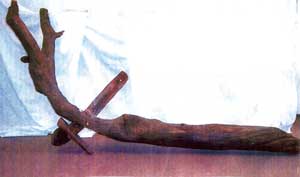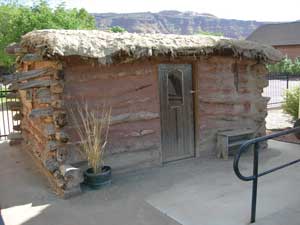
This cottonwood plough was found at mineral bottom on the Green River by Max Irish and Ellis Stocks. They donated it to the Daughters of Utah Pioneers. Photo by Hallie Tibbitts |
Newcomers to Utah -- or travelers -- may be caught off guard when July 24 rolls around and all state government offices, including the liquor stores, are shut down that day for a holiday. It’s about Mormon pride, mostly, but has evolved into a celebration of early explorers and other settlers as well.
Pioneer Day falls on a Saturday this year.
For July 24, members of the dominant religion of Utah, the Church of Jesus Christ of Latter-day Saints, plan gatherings and activities to commemorate the day in 1847 when religious leader Brigham Young, second president and prophet of the fledgling church founded in New York, announced to a weary band of explorers on a mountaintop overlooking the Salt Lake Valley that they had reached their destination -- the “land of Zion,” in the State of Deseret.
“This is the place,” Brigham Young declared.
THE COTTONWOOD PLOUGH
THE FORK OF A COTTONWOOD ANSWERED HIS NEED,
WITH THE TRUNK CHAINED TO HIS HORSE,
HE MADE FURROWS FOR SEED.
PLANTED IN ROWS THE STICK MADE IN THE SAND
AND A PRAYER SENT TO HEAVEN TO BLESS THIS LAND.
HE EARNED HIS BREAD BY THE SWEAT OF HIS BROW,
THIS STURDY, COURAGEOUS PIONEER,
WITH HIS COTTONWOOD PLOUGH
--Hollie Tibbitts |
Since then, July 24 has been recognized throughout Utah as Pioneer Day. Just like the local chapter of the international societies of the Sons and Daughters of Utah Pioneers, Pioneer Day isn’t just about Mormons. It’s about pioneers who settled Utah.
It used to be that Mormons and other churches in Moab joined together and organized activities in recognition of the pioneers of southern Utah, always including an open-invitation picnic at the park, and a parade down Main Street. Floats in the parade and participants predominantly featured lots of happy, energetic children.
Salt Lake City, the hub of Zion, still produces a Pioneer Day Parade. And travelers may encounter parades in other areas more concentrated with Mormon populations. But Moab carries on as usual, no parade interrupting the flow of recreational vehicles packing downtown Main Street from one streetlight to the next; no marquees or banners announcing the pioneers’ arrival to Utah Territory, or the “far country” of Moab in 1855.
The legacy of Mormon involvement in settling the Moab Valley is mostly nurtured by the local chapter of the 19,000-member international society of the DUP, which was organized April 11, 1901, in Salt Lake. The Moab “camp” of the Grand Company of the DUP -- formed in November 1934 -- maintains a stone monument near their museum bearing a plaque in remembrance of a mission fort completed July 15, 1855 by the Mormons near springs in north Moab.
The memorial plaque, now located about two blocks east of Main Street between Center and 100 North, states that the Mormons’ Elk Mountain Mission fort was about 800 feet away. However, the monument, erected in 1940, has been moved twice since then to make way for development. The local “company” of pioneer descendants (which alludes to the flow of wagon trains led west before 1869 by captains assigned by Mormon leadership) is currently engaged in a project to add a smaller plaque to the monument that accurately states the former location of the fort at the corner of 500 West and State Highway 191.
Local DUP president Bette Wimmer noted that the Moab camp is also gearing up to address concerns about the deteriorating condition of the sod roof on an old log cabin that was moved for preservation next to the DUP museum. Moisture and gravity have taken their toll, the roof could cave in, and members are unsure whether to build a protective structure over the cabin or replace the roof again with natural materials. Suggestions and donations are welcome.
 Old Log Cabin
Old Log Cabin |
At the site of the Old Log Cabin, visitors learn that it is the oldest one remaining in Moab, likely built in 1881 by Randolph Stewart for his third wife. Later, the Stanley family occupied the cabin after leaving the Wolfe Ranch (now preserved at Arches National Park) in 1908. Howard Balsley, one of Moab’s renowned uranium millionaires, also shared the cabin in 1912 with “Bish” Taylor, the first publisher of the Moab Times-Independent. The cabin is listed as an historic landmark on the National Register of Historic Places.
Hallie Tibbitts, a longstanding and active participant in the local 42-member company, welcomes any resident or out-of-towner to visit the DUP museum, Elk Mountain monument and cabin. During the summer, she opens the museum on Friday evenings at 6 p.m.
Editor’s Note: Author Vicki Barker is a member of the DUP Moab Camp. |

